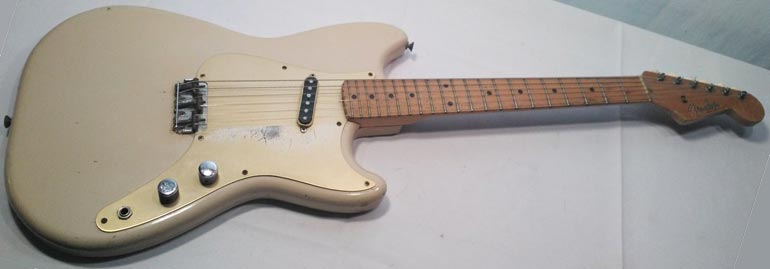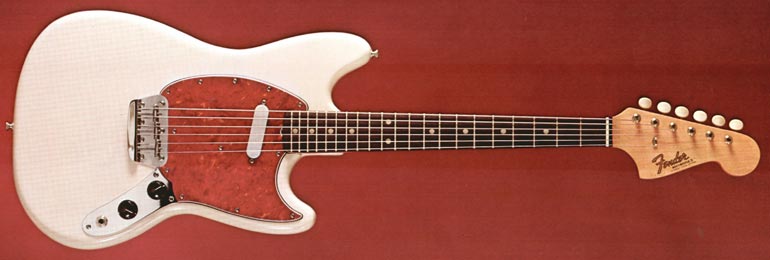

The three-quarter size Fender Musicmaster debuted in 1956, as a new student model in the Fender solid body range. It was joined shortly afterwards by a dual pickup companion model, the Duo-Sonic. Although these 'student' guitars were shorter scale than the Fender standard (22 1/2" vs 25"), they were not 'student' in terms of build quality - in fact very much in line with the Fender professional models such as the Telecaster and Stratocaster. The 1950s Fender Musicmaster was described as three quarter size, but the difference in size was not so great: Fender also suggested these models for more established players with smaller hands. But in truth, most experienced guitarists wanting to play widely spaced chords or the extra speed afforded by closer frets would chose the dual pickup Duo-Sonic - assuming price was not an issue!
Fender always believed that if beginner guitarists chose Fender, they would more likely continue playing Fender guitars as they got older. This fact was demonstrated on the cover of the 1958 'Down Beat' brochure - an adult plays a Fender Stratocaster, whilst a child looks on, Fender Musicmaster in hand. As Fender put it in the 1976 catalog "Begin with a Musicmaster, and graduate to stardom!".
The Musicmaster was clearly a success, remaining in continuous production until 1982.

1958 Fender Musicmaster Image Heritage auctions

The early Musicmaster, though well-built, was a very simple instrument. Just a single coil pickup in the neck position with one one and one volume control. Bodies were typically Ash, and later alder, finished in a light creamy color: Desert Sand, with a rather fetching gold anodized aluminium scratchplate. Simple, but effective. Necks had 21 fret maple fretboards with Fender's clay dot position markers.

As with most guitars with a long production run, the Musicmaster was subject to subtle changes in specification over the years. The first remodelling came in 1959: the most obvious changes being the addition of Sunburst as a finish option, and a new rosewood fretboard. The gold aluminium pickguard was replaced by single ply white plastic, and pickup covers changed from white to black. The new version Musicmaster can be seen in the 1960 Fender brochure.
The next major update came in 1964. Fender redesigned both the Musicmaster and Duo-Sonic in line with the brand new Fender Mustang. All three models had the same new body shape, and a choice of the old 3/4 size 22 1/2" neck, or a longer 24" neck. The differences between the guitars were purely related to hardware: a single pickup for the Musicmaster, two pickups for the Duo-Sonic and Mustang, and a tremolo for the Mustang. Each model had a new bridge, without cover. The three guitars were all offered in the same three finishes: Red, White or Blue. Interestingly, the list price was reduced (slightly) from $129.50 to $126 at this time - for either scale neck.

1965 Fender Musicmaster Image Heritage auctions

1970 Fender Musicmaster from the 1970 Fender catalogue

The final redesign of the Duo-Sonic and Musicmaster was described in the November 1964 edition of Fender newsletter Fender Facts
The Musicmaster and Duo-Sonic have recently undergone changes which we believe their performance and appearance.
The bodies of both instruments are now contoured similar to that of the Mustang. They are available in red, white or blue finishes with either a 22 1/2 or 24 inch neck.
Both guitars have a full range tone control and in addition, the Duo-Sonic is provided with a three-position switch for each pickup. The middle position turns the pickups off and tone changes will be made on either side of the off position. Eight different tone selections are therefor available, plus the normal tone and volume controls.
The Duo-Sonic dual pickup and Musicmaster single pickup 3/4 or regular size guitars are truly outstanding instruments in their price range and will provide top performance and appearance.
Model launch. 22 1/2" scale Desert Sand finish. Maple fretboard, gold pickguard
1957 (February) price: $119.50

The 1958 Fender 'Down Beat' catalogue shows a child having a guitar lesson on his Fender Musicmaster.
Plastic single ply scratchplate, rosewood fretboard

1960 (July) price: $129.50
1961 (July) price: $129.50
1962 (September) price: $129.50
1963 (July) price: $129.50
1964 (April) price: $129.50. Mid 1964 publicity describe two finish options: white (with black pickguard) or red mahogany (with white pickguard).

Fender Facts 8 (November, 1964) announces the 'Improved' Musicmaster
Late 1964: the Fender Musicmaster is redesigned and brought into line with the new Fender Mustang. 22 1/2" or 24" scale necks now available. Red, White and Blue finishes now available.
1965 (December) price: $126 (case $34 extra)
1966 (February, July) price: $126 (case $34 extra)
1967 (June, October) price: $126 (case $35 extra)
1968 (March, July) price: $134.50 (case $35 extra)

1969 (May) price: $154.50 (case $37.50 extra)
1970 (April) price: $162.50. Finishes Red (515), White (516), Blue (517)
1971 (January) price: $162.50 (case $39.50 extra)
1972 (February) price: $162.50 (case $31/$39.50 extra)
1973 (June) price: $162.50 (case $31/$39.50 extra)
1974 (December) price: $180 (case $34/$45 extra)

The 1976 Fender catalogue just lists two finish options for the Musicmaster: Black or White. Note both are fitted with a black scratchplate
1977 (December) price: $220 ($250 with case). Black or White finishes only
Wine and Black finishes only
Model discontinued
$1500
$2525
$230
$3590
$1199
$4395
$2590
$1475
$1795
$1450
$3350
$1595
$399
$2500
$2919
$1999
$2995
$2500
$2250
$3299